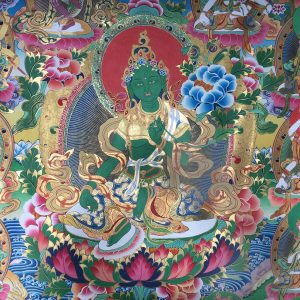The Vajrayana Program
 The Vajrayana (the “Diamond Vehicle”) represents a branch of Mahayana Buddhism that was brought to Tibet in the seventh and eighth centuries by the Indian Mahasiddha Padmasambhava. This form of Buddhist practice became the main spiritual tradition of Tibet. The practices and doctrines set forth in the Vajrayana work expediently to purify practitioners of obscurations, karmic conditionings, and blockages that impede our
The Vajrayana (the “Diamond Vehicle”) represents a branch of Mahayana Buddhism that was brought to Tibet in the seventh and eighth centuries by the Indian Mahasiddha Padmasambhava. This form of Buddhist practice became the main spiritual tradition of Tibet. The practices and doctrines set forth in the Vajrayana work expediently to purify practitioners of obscurations, karmic conditionings, and blockages that impede our
capacity to both recognize and live from the most awake and free dimension of our being – the wise and compassionate nature of our heart/mind.
The Vajrayana includes sets of yogic technologies aimed at opening, awakening, and melting our frozen emotional and conceptual energies to free us from the habitual thoughts and emotional patterns of reactivity that usually structure our relationship with ourselves, others, and the world around us. Through Vajrayana practice and study, we learn to embrace ordinary thoughts and emotions as the unlikely catalysts for recognizing that our nature, and the nature of others, is love and wisdom inseparable.
In the practices of Vajrayana, we especially welcome the challenging aspects of life—our difficult thoughts, emotions, and physical reality—as the fodder for awakening. This shift in perspective, from our usual antagonistic relationship to the difficult to a relationship of friendliness, curiosity, and clarity, implies that meditation is not left on the cushion, but rather is an active and dynamic process that involves utilizing body, speech, and action as potentially transformative and liberating practices.
Vajrayana practice includes foundation practices (ngöndro), deity visualization practices, connection with lineage-based teachings, energy body yogas, and deep retreating. The foundation practices—generally the first step in Vajrayana development— introduce practitioners to the principles of visualization, deity yoga and lineage connection.
Students interested in exploring Vajrayana skillful means to enhance their training in natural awareness and bodhicitta should contact .
Please note: NDF’s Vajrayana track is usually only open to students who have completed the NDF’s two-year Margha program.